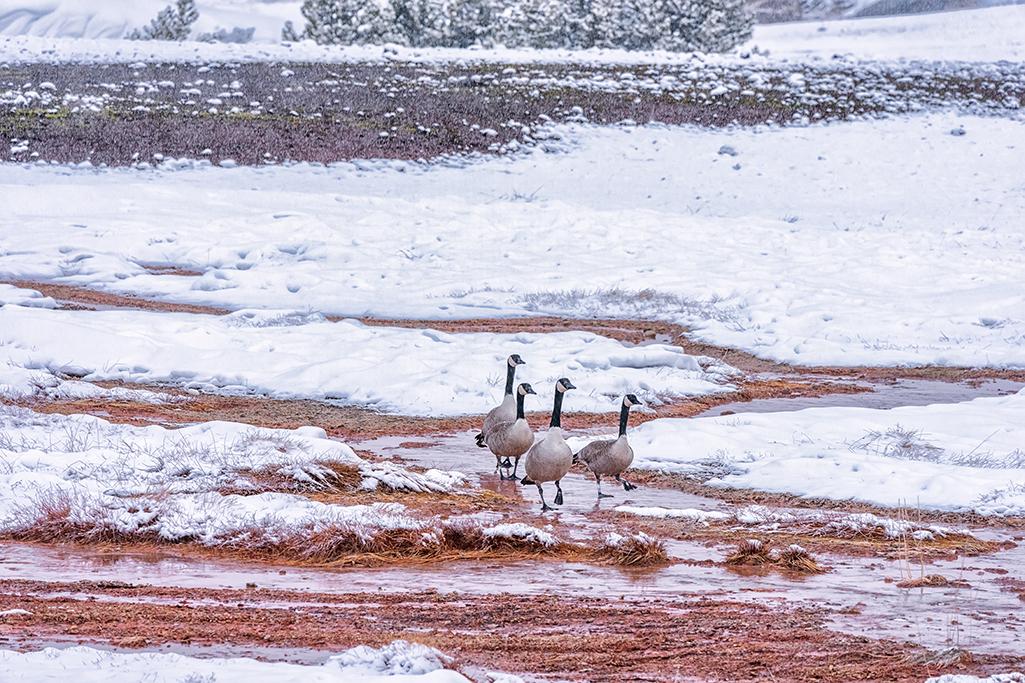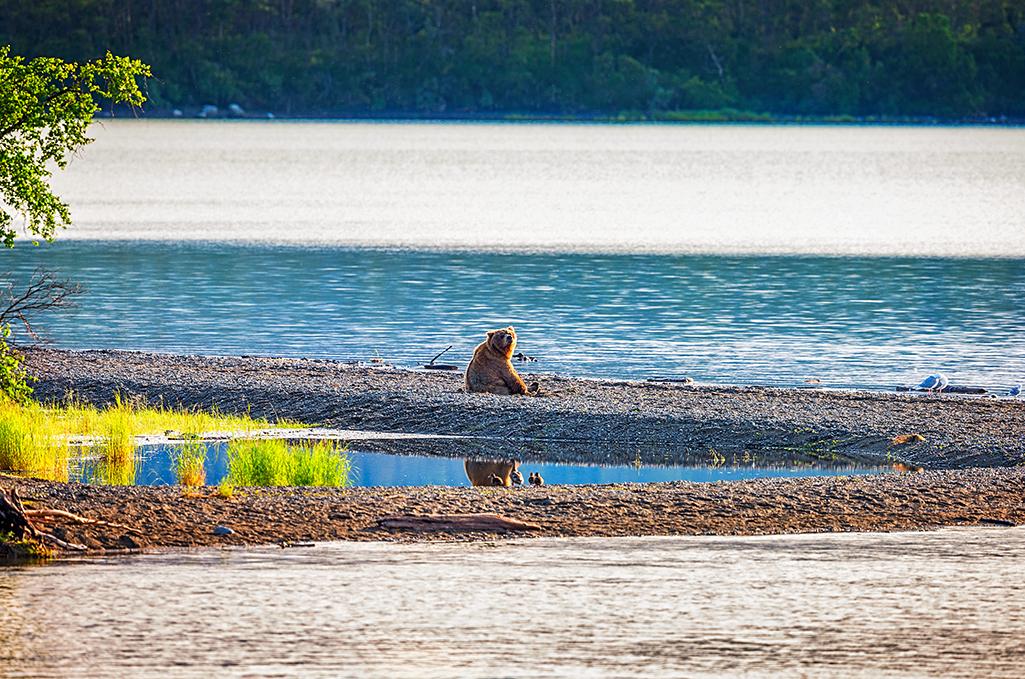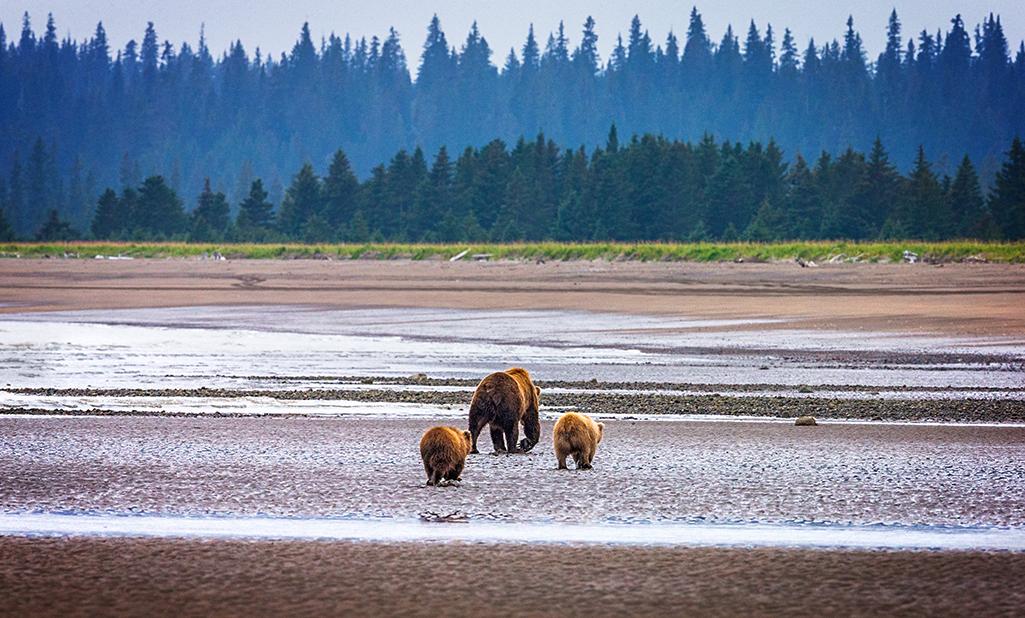
Canada geese wading through Old Faithful runoff in the winter, Yellowstone National Park / Rebecca Latson
I’ve mentioned this more than once in my photo articles for the Traveler, including this 2022 article about a winter visit to Yellowstone National Park. Sometimes, you see amazing wildlife during your national park adventure, but you just don’t have the right lens on your camera, or maybe your telephoto lens (or setting) doesn’t far enough reach for a sharp, close-up shot. Go ahead and capture that wildlife image anyway! Sure, that bear or moose or elk might be quite a distance away from you and your camera (as it should be, actually), but you’ve photographed something very important in relation to the wildlife: you’ve achieved a beautiful landscape shot of the environment in which that wildlife dwells. You’ve got wildlife in the landscape … or rather, a landscape with wildlife.
This month’s column is all about examples of the beauty of a landscape image containing wildlife along with tips for getting great shots without a big honkin’ telephoto lens. Photographers must make do with whatever they are handed, be it weather or wildlife, and these examples are proof you can get awesome images even if they aren’t what you’d originally planned on capturing.
As you view wildlife in a broad setting such as in the images below of a moose in Fishercap Lake at Glacier National Park in Montana and an Alaskan brown bear sitting hunched over on the beach at Naknek Lake in Katmai National Park and Preserve in Alaska, think first about how fast this wildlife is moving. Slow-moving-to-still wildlife in a wide(er)-angle setting is going to allow you more time in which to frame your composition for both the landscape and the wildlife, resulting in a clear shot. That’s a good thing if you don’t have a lens with a large focal length. Really, it’s a good thing even if you do have a large telephoto lens but the animal is still too far for a close shot.

A moose in Fishercap Lake, Many Glacier area, Glacier National Park / Rebecca Latson

Bear on the beach, Katmai National Park and Preserve / Rebecca Latson
I’ve written before how you should concentrate on the small things as well as the large when capturing great images because even the little things contribute to fleshing out your national park story. Sometimes, your wildlife is very small, like this little squirrel standing upright on the rock over the abyss of Yosemite Valley at Glacier Point Vista in Yosemite National Park. Do you think this little guy or gal felt insignificant within the grandeur of the valley below? Or do you think he/she was just angling for a tasty (but forbidden) handout from some nearby human who saw this cute little critter posing on the big rock?

Itty bitty on a large ledge, Yosemite National Park / Rebecca Latson
Far-away wildlife presents great scale (and reference) emphasizing the vastness of the landscape, like the lone deer grazing in the green meadow at Yosemite Valley against the tall tree line and soaring granite cliff face in the background.

Grazing amidst the grandeur in Yosemite Valley, Yosemite National Park / Rebecca Latson
If people get in the frame, go ahead and include them in your shot, too. People often add a more complex telling of that scene’s story in relation to the wildlife in the landscape. The story in this image is of a couple of fishermen standing on the shore between the Brooks River and Naknek Lake. Perhaps they were wondering if they should fish near that bruin. Anglers competed with the brown bears for salmon in this river and you can probably guess who usually won the competition (hint: not the humans).

For something a little different, sometimes converting a color image of wide-angle wildlife into a monochrome shot adds an interesting element to the composition. Some camera settings allow you to capture original images in monochrome, but I advise capturing your photos in color and later converting a copy of the image to black-and-white or sepia.

Itty bitty in black-and-white, Yosemite National Park / Rebecca Latson
Even if you don’t capture the face of an animal in your distant photo, people will still know the wildlife at which they look. Sometimes, that can even add a bit of humor or cuteness to the image.

Bear butts on the beach, Lake Clark National Park and Preserve / Rebecca Latson
If you want to emphasize your far-away wildlife a little more wtihin your landscape shot, why not add a little bit (or a lot, depending upon your taste) of vignetting to the image. Vignetting used to be a bad word in photography because it meant a part of your lens filter was showing up in your photo to create an opaque circle all around the image edges. In truth, you can add vignetting to a photo (think of those old-timey Western portraits) and it looks quite nice, encouraging your viewers to focus more on your wildlife subject. Most photo editing software includes a slider or icon for adding that vignette and you can choose just how much darkness you want around the edges. Compare the image below with the image above. Which do you prefer? Remember, photography is a subjective art, so there's no wrong choice here.

Bear butts on the beach witih a little vignetting added, Lake Clark National Park and Preserve / Rebecca Latson
When it comes to choosing whether or not to light up the wildlife or the landscape in your composition, I advise setting your camera’s exposure for the best light on the landscape. You can always go in and edit the image to lighten or darken the wildlife. Your overall composition is the landscape itself. Distant wildlife enhances that landscape. Smartphone and point-and-shoot users, your cameras’ auto settings usually do a pretty good job with determining overall exposure. SLR users, you can use auto settings too for decent imagery, but to understand your camera and get the best out of it, you should practice with the other settings, too, including the manual setting (not as difficult as you think, since you have instant LCD feedback on whether your settings choices made the shot too dark or too light).
To capture this bison in the winter image at Yellowstone National Park, I exposed for the white snow rather than the dark bison. Had I tried to expose for the bison (to lighten it up for more detail), the snow would have been blown out (overexposed). Later, during the editing stage, I specifically lightened up that lone fluffy cow a little bit without changing the rest of the photo.

Bison at Upper Geyser Basin in the winter, Yellowstone National Park / Rebecca Latson
If you have a big honkin’ telephoto lens, by all means, get that close-up portrait of a fox or moose or bear or elk you see during your national park visit. But if your lens doesn’t have quite the reach, you should still click that shutter button to capture a great wildlife composition which will clue your viewing audience into where the wildlife lives and roams. Sometimes, the Big Picture is not literally a big headshot but rather a wide-angle view of the wildlife and the landscape.

Bison on the Yellowstone landscape, Yellowstone National Park / Rebecca Latson




 Support Essential Coverage of Essential Places
Support Essential Coverage of Essential Places






